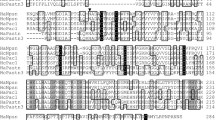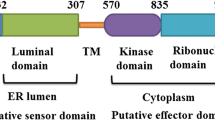Abstract
A cDNA encoding a novel phospholipase A2 (PLA2), which was named IN PLA2, was cloned from the intestine of the red sea bream. The amino acid sequence of IN PLA2 showed 49–75% homology with those of red sea bream group IB sPLA2, hepatopancreas DE-1 and DE-2 PLA2, and gill G-3 PLA2. IN PLA2 consists of a prepropeptide of 24 amino acid residues, followed by a mature protein. IN PLA2 contains 14 cysteines, and includes Cys11, the calcium binding loop and the pancreatic loop that are commonly conserved in group IB sPLA2 enzymes. In addition, IN PLA2 is a cationic protein with a pI of 8.52. Therefore, IN PLA2 was identified as a novel group IB sPLA2 isoform in red sea bream. IN PLA2 mRNA was found by northern blot analysis to be expressed mainly in the pyloric caeca and the intestine, and was detected in the goblet cells of the intestine by in situ hybridization. The expression level of IN PLA2 mRNA was elevated by intravenous injection of lipopolysaccharide—the outer-membrane component of Gram-negative bacteria. These results suggest that IN PLA2 is secreted from the goblet cells of the intestine in response to stimulus such as bacterial infection, and that it contributes to antimicrobial defense in addition to the digestion of dietary phospholipids in the gastrointestinal tract.







Similar content being viewed by others
References
Six DA, Dennis EA (2000) The expanding superfamily of phospholipase A2 enzymes: classification and characterization. Biochim Biophys Acta 1488(1–2):1–19
Gelb MH, Valentin E, Ghomashchi F, Lazdunski M, Lambeau G (2000) Cloning and recombinant expression of a structurally novel human secreted phospholipase A2. J Biol Chem 275(51):39823–39826
Kishimura H, Ojima T, Hayashi K, Nishita K (2000) cDNA cloning and sequencing of phospholipase A2 from the pyloric ceca of the starfish Asterina pectinifera. Comp Biochem Physiol B Biochem Mol Biol 126(4):579–586
Talvinen KA, Nevalainen TJ (2002) Cloning of a novel phospholipase A2 from the cnidarian Adamsia carciniopados. Comp Biochem Physiol B Biochem Mol Biol 132(3):571–578
Murakami M, Masuda S, Shimbara S, Bezzine S, Lazdunski M, Lambeau G, Gelb MH, Matsukura S, Kokubu F, Adachi M, Kudo I (2003) Cellular arachidonate-releasing function of novel classes of secretory phospholipase A2 s (groups III and XII). J Biol Chem 278(12):10657–10667
Lee HY, Bahn SC, Shin JS, Hwang I, Back K, Doelling JH, Ryu SB (2005) Multiple forms of secretory phospholipase A2 in plants. Prog Lipid Res 44(1):52–67
Schaloske RH, Dennis EA (2006) The phospholipase A2 superfamily and its group numbering system. Biochim Biophys Acta 1761(11):1246–1259
Seilhamer JJ, Randall TL, Yamanaka M, Johnson LK (1986) Pancreatic phospholipase A2: isolation of the human gene and cDNAs from porcine pancreas and human lung. DNA 5(6):519–527
Tojo H, Ono T, Kuramitsu S, Kagamiyama H, Okamoto M (1988) A phospholipase A2 in the supernatant fraction of rat spleen. Its similarity to rat pancreatic phospholipase A2. J Biol Chem 263(12):5724–5731
Sakata T, Nakamura E, Tsuruta Y, Tamaki M, Teraoka H, Tojo H, Ono T, Okamoto M (1989) Presence of pancreatic-type phospholipase A2 mRNA in rat gastric mucosa and lung. Biochim Biophys Acta 1007(1):124–126
Tojo H, Ono T, Okamoto M (1991) Spleen phospholipases A2. Methods Enzymol 197:390–399
Tojo H, Ono T, Okamoto M (1993) Reverse-phase high-performance liquid chromatographic assay of phospholipases: application of spectrophotometric detection to rat phospholipase A2 isozymes. J Lipid Res 34(5):837–844
Kortesuo PT, Hietaranta AJ, Jamia M, Hirsimaki P, Nevalainen TJ (1993) Rat pancreatic phospholipase A2. Purification, localization, and development of an enzyme immunoassay. Int J Pancreatol 13(2):111–118
Hara S, Kudo I, Komatani T, Takahashi K, Nakatani Y, Natori Y, Ohshima M, Inoue K (1995) Detection and purification of two 14 kDa phospholipase A2 isoforms in rat kidney: their role in eicosanoid synthesis. Biochim Biophys Acta 1257(1):11–17
Aarsman AJ, Schalkwijk CG, Neys FW, Iijima N, Wherrett JR, van den Bosch H (1996) Purification and characterization of Ca(2 +)-dependent phospholipases A2 from rat kidney. Arch Biochem Biophys 331(1):95–103
Ohara O, Ishizaki J, Arita H (1995) Structure and function of phospholipase A2 receptor. Prog Lipid Res 34(2):117–138
Kundu GC, Mukherjee AB (1997) Evidence that porcine pancreatic phospholipase A2 via its high affinity receptor stimulates extracellular matrix invasion by normal and cancer cells. J Biol Chem 272(4):2346–2453
Hanasaki K, Yokota Y, Ishizaki J, Itoh T, Arita H (1997) Resistance to endotoxic shock in phospholipase A2 receptor-deficient mice. J Biol Chem 272(52):32792–32797
Valentin E, Lambeau G (2000) Increasing molecular diversity of secreted phospholipases A2 and their receptors and binding proteins. Biochim Biophys Acta 1488(1–2):59–70
Zambonino Infante JL, Cahu CL (1999) High dietary lipid levels enhance digestive tract maturation and improve Dicentrarchus labrax larval development. J Nutr 129:1195–2000
Iijima N, Chosa S, Uematsu K, Goto T, Hoshita T, Kayama M (1997) Purification and characterization of phospholipase A2 isoforms from the pyloric caeca of Red Sea Bream, Pagrus major. Fish Physiol Biochem 18:135–147
Iijima N, Fujikawa Y, Tateishi Y, Takashima Y, Uchiyama S, Esaka M (2001) Cloning and expression of group IB phospholipase A2 isoforms in the red sea bream, Pagrus major. Lipids 36(5):499–506
Iijima N, Uchiyama S, Fujikawa Y, Esaka M (2000) Purification, characterization, and molecular cloning of group I phospholipases A2 from the gills of the red sea bream, Pagrus major. Lipids 35(12):1359–1370
Murakami M, Kudo I (2002) Phospholipase A2. J Biochem 131(3):285–292
Singer AG, Ghomashchi F, Le Calvez C, Bollinger J, Bezzine S, Rouault M, Sadilek M, Nguyen E, Lazdunski M, Lambeau G, Gelb MH (2002) Interfacial kinetic and binding properties of the complete set of human and mouse groups I, II, V, X, and XII secreted phospholipases A2. J Biol Chem 277(50):48535–48549
Thompson JD, Higgins DG, Gibson TJ (1994) CLUSTAL W: improving the sensitivity of progressive multiple sequence alignment through sequence weighting, position-specific gap penalties and weight matrix choice. Nucleic Acids Res 22(22):4673–4680
Page RD (1996) TreeView: an application to display phylogenetic trees on personal computers. Comput Appl Biosci 12(4):357–358
Uchiyama S, Fujikawa Y, Uematsu K, Matsuda H, Aida S, Iijima N (2002) Localization of group IB phospholipase A2 isoform in the gills of the red sea bream, Pagrus (Chrysophrys) major. Comp Biochem Physiol B Biochem Mol Biol 132(3):671–683
Moon HW, Whipp SC, Baetz AL (1971) Comparative effects of enterotoxins from Escherichia coli and Vibrio cholerae on rabbit and swine small intestine. Lab Invest 25(2):133–140
Hara N, Murakami M, Nakatani Y, Inoue K, Kudo I (1997) Characterization and molecular cloning of mouse type II phospholipase A2. Adv Exp Med Biol 407:109–116
Nakano T, Arita H (1990) Enhanced expression of group II phospholipase A2 gene in the tissues of endotoxin shock rats and its suppression by glucocorticoid. FEBS Lett 273(1–2):23–26
Madsen LM, Inada M, Weiss J (1996) Determinants of activation by complement of group II phospholipase A2 acting against Escherichia coli. Infect Immun 64(7):2425–2430
Weinrauch Y, Elsbach P, Madsen LM, Foreman A, Weiss J (1996) The potent anti-Staphylococcus aureus activity of a sterile rabbit inflammatory fluid is due to a 14-kD phospholipase A2. J Clin Invest 97(1):250–257
Author information
Authors and Affiliations
Corresponding author
Rights and permissions
About this article
Cite this article
Fujikawa, Y., Uematsu, K. & Iijima, N. cDNA cloning and expression of a novel group IB phospholipase A2 in the intestine of the red sea bream, Pagrus (Chrysophrys) major . Fish Sci 75, 453–461 (2009). https://doi.org/10.1007/s12562-008-0049-x
Received:
Accepted:
Published:
Issue Date:
DOI: https://doi.org/10.1007/s12562-008-0049-x




